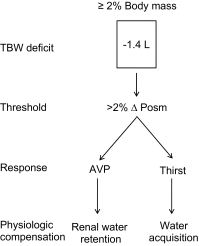Drinking Strategies: Planned Drinking Versus Drinking to Thirst
- PMID: 29368181
- PMCID: PMC5790864
- DOI: 10.1007/s40279-017-0844-6
Drinking Strategies: Planned Drinking Versus Drinking to Thirst
Abstract
In humans, thirst tends to be alleviated before complete rehydration is achieved. When sweating rates are high and ad libitum fluid consumption is not sufficient to replace sweat losses, a cumulative loss in body water results. Body mass losses of 2% or greater take time to accumulate. Dehydration of ≥ 2% body mass is associated with impaired thermoregulatory function, elevated cardiovascular strain and, in many conditions (e.g., warmer, longer, more intense), impaired aerobic exercise performance. Circumstances where planned drinking is optimal include longer duration activities of > 90 min, particularly in the heat; higher-intensity exercise with high sweat rates; exercise where performance is a concern; and when carbohydrate intake of 1 g/min is desired. Individuals with high sweat rates and/or those concerned with exercise performance should determine sweat rates under conditions (exercise intensity, pace) and environments similar to that anticipated when competing and tailor drinking to prevent body mass losses > 2%. Circumstances where drinking to thirst may be sufficient include short duration exercise of < 1 h to 90 min; exercise in cooler conditions; and lower-intensity exercise. It is recommended to never drink so much that weight is gained.
Conflict of interest statement
Funding
This article was published in a supplement supported by the Gatorade Sports Science Institute (GSSI). The supplement was guest edited by Lawrence L. Spriet who attended a meeting of the GSSI expert panel in October 2016 and received honoraria from the GSSI for his participation in the meeting and the writing of a manuscript. He received no honoraria for guest editing the supplement. Dr Spriet selected peer reviewers for each paper and managed the process, except for his own paper. Robert Kenefick also attended the meeting of the GSSI expert panel in October 2016 and received an honorarium from the GSSI, a division of PepsiCo, Inc. for his meeting participation and the writing of this manuscript. The views expressed in this manuscript are those of the author and do not necessarily reflect the position or policy of PepsiCo, Inc.
Conflicts of interest
The author, Robert W. Kenefick, has no potential conflicts of interest regarding this article.
Figures





Comment in
-
Author's Reply to Valenzuela et al.: Comment on "Drinking Strategies: Planned Drinking Versus Drinking to Thirst".Sports Med. 2018 Sep;48(9):2215-2217. doi: 10.1007/s40279-018-0902-8. Sports Med. 2018. PMID: 29582379 No abstract available.
-
Comment on: "Drinking Strategies: Planned Drinking versus Drinking to Thirst".Sports Med. 2018 Sep;48(9):2211-2213. doi: 10.1007/s40279-018-0905-5. Sports Med. 2018. PMID: 29582380 No abstract available.
-
Author's Reply to Goulet: Comment on: "Drinking Strategies: Planned Drinking Versus Drinking to Thirst''.Sports Med. 2019 Apr;49(4):635-636. doi: 10.1007/s40279-018-0966-5. Sports Med. 2019. PMID: 30094800 No abstract available.
-
Comment on "Drinking Strategies: Planned Drinking Versus Drinking to Thirst''.Sports Med. 2019 Apr;49(4):631-633. doi: 10.1007/s40279-018-0973-6. Sports Med. 2019. PMID: 30094801 No abstract available.
-
Comment on "Drinking Strategies: Planned Drinking Versus Drinking to Thirst".Sports Med. 2019 Jul;49(7):1133-1134. doi: 10.1007/s40279-018-1026-x. Sports Med. 2019. PMID: 30471021 No abstract available.
References
Publication types
MeSH terms
Substances
LinkOut - more resources
Full Text Sources
Other Literature Sources
Medical

